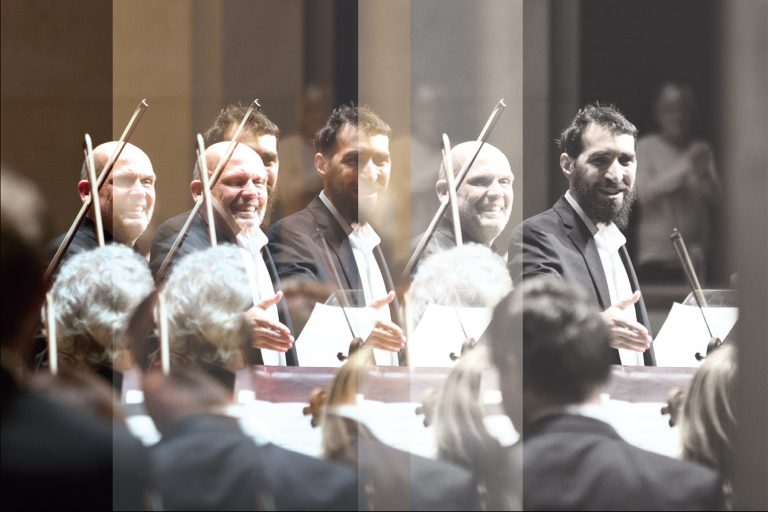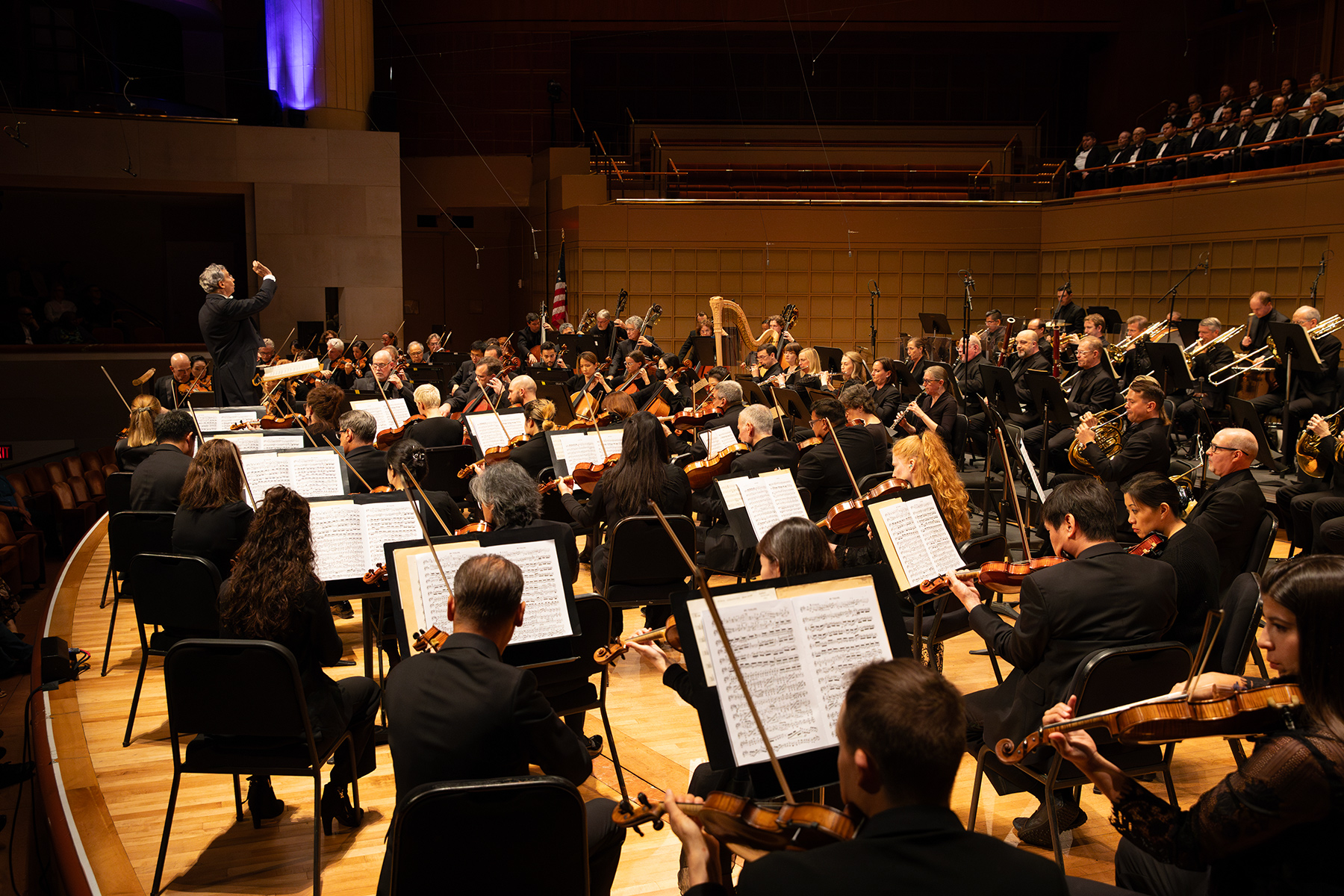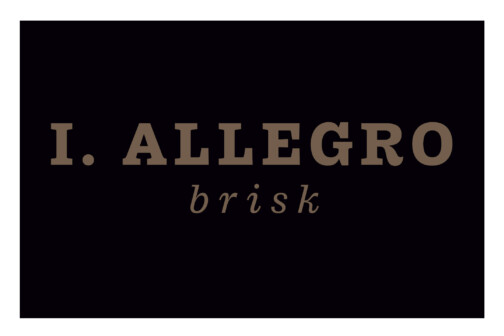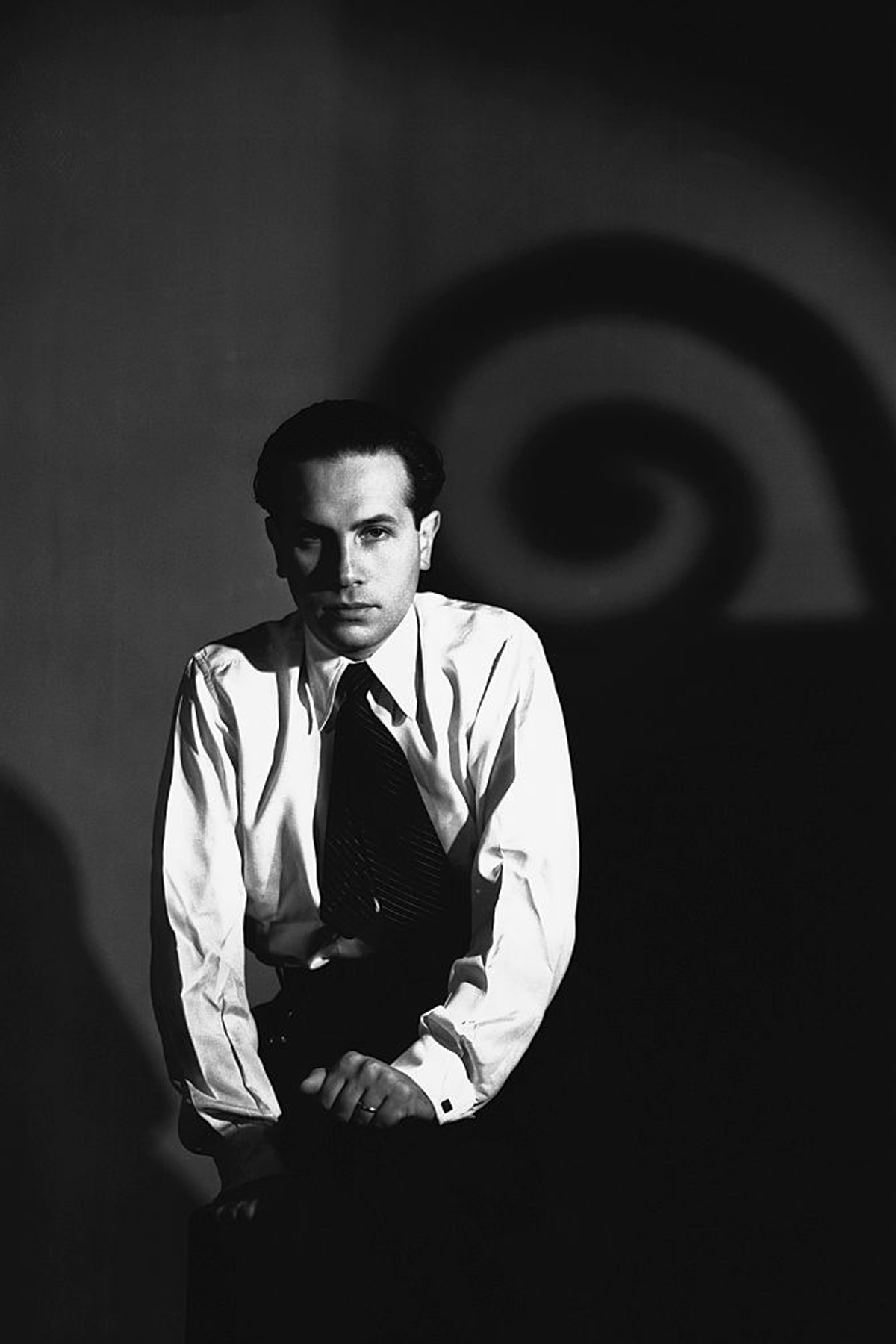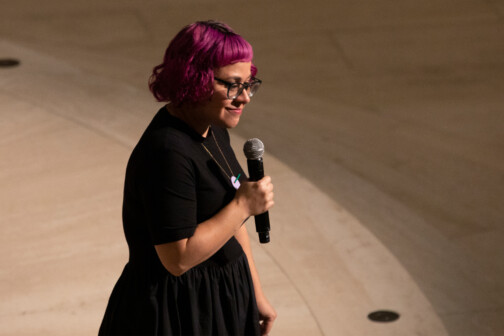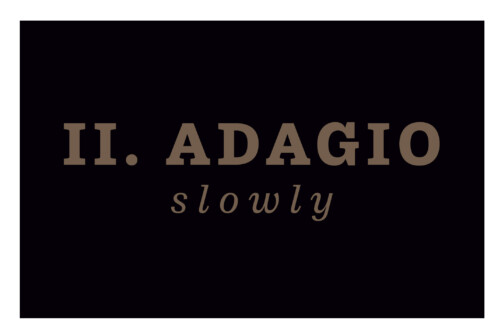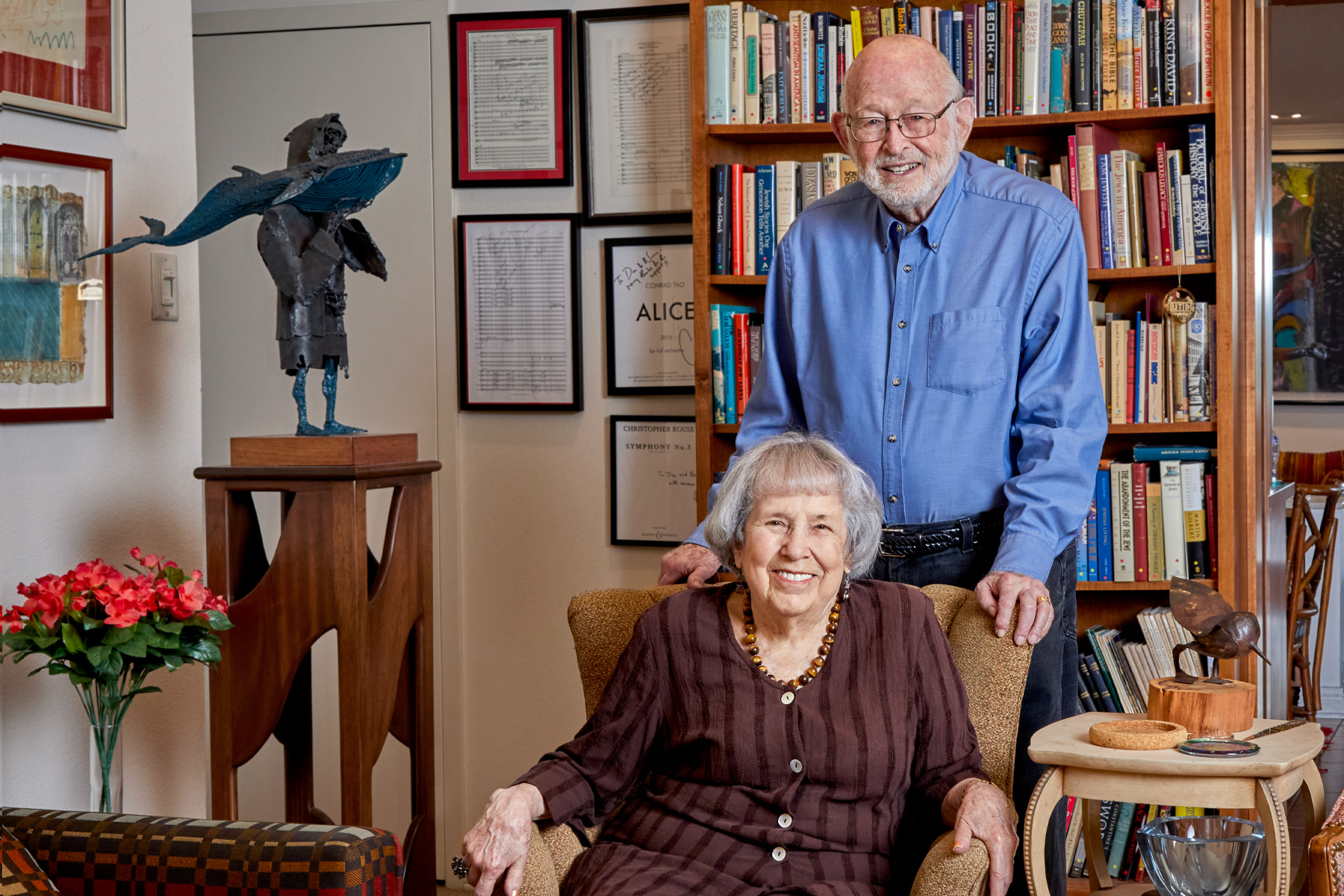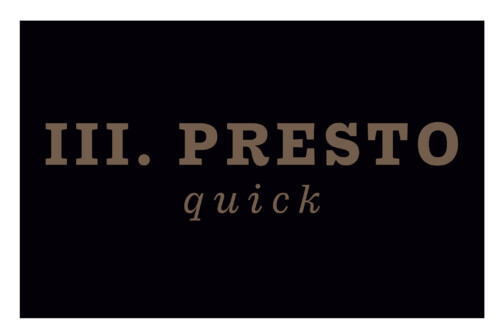High atop downtown’s J. Erik Jonsson Central Library, there is a locked, unmarked room that contains some of the city’s most important artifacts. One day this summer, I found myself sitting there on the floor.
“Use this box of gloves. I’m trusting you not to take anything,” said Denise McGovern, an executive with the Dallas Symphony Orchestra.
McGovern was my co-researcher and chaperone. With an appointment elsewhere, she left me alone with the protective rubber gloves and a century of history: yellowed newspaper clippings, brittle vinyl records, gala invitations, and metal shelves full of old concert programs. The DSO’s private archive looks chaotic—part safe-deposit vault, part attic—but it is an irreplaceable diary of our city’s musical history.
Every year, the orchestra performs new pieces written for Dallas audiences. Through these world premieres, the orchestra makes a permanent mark on the future of classical music. But what happens to new music after its first performance? Does it get played again? Can we claim credit for any local masterpieces? Who picks the tunes, and who pays for them?
These questions led me into the Dallas Symphony archives, where orchestra employees and I read through every old concert program we could find, looking for forgotten symphonies and, if we were lucky, some genuine classics. For the first time, we built a database of music that Dallas can call its own. After talking with composers, performers, and donors, I felt grateful to live in the present time—because, when it comes to new symphonic music in Dallas, our golden age is upon us.
The first record of the Dallas Symphony playing original music dates to 1912. At that time, the DSO was an ensemble of eager amateurs led by unpaid conductors. One of them, a German immigrant named Carl Venth, debuted a series of his own ambitious works: an Easter “Resurrection” oratorio, a symphony based on Icelandic sagas, and multiple depictions of Greek myths. (Less imposing was his “mosquito dance” featuring violins as buzzing insects.)
For several decades, the orchestra was a stop-and-start semi-pro organization, liable to miss entire seasons when short on either funding or interest. Premieres of this era were opportunistic, and explained as such in programs: the conductor wrote something over the winter, or met a composer on vacation. The DSO skipped World War II, but when the war ended, it quickly reorganized—this time on a professional basis, with full-time salaries.
For both artistic and geopolitical reasons, the postwar era found American orchestras promoting hours of new classical music. Our music scene embraced French, German, Italian, and central European musicians fleeing fascism and antisemitism, keeping them employed at orchestras, universities, and Hollywood studios. Hungarian composer-conductor Antal Doráti flew through Fort Worth while traveling, sat for a job interview on the airport tarmac, and agreed to lead the DSO as it turned pro. He arrived at his new gig with new music from all his friends.
In Dallas, Doráti arranged the American premiere of his teacher Béla Bartók’s creepy symbolist opera Bluebeard’s Castle, broadcast nationally on NBC radio. Composer Paul Hindemith, who emigrated from Germany because his wife had Jewish blood and Joseph Goebbels had called him an “atonal noisemaker,” wrote one of his largest orchestral works, the Symphonia Serena, for Doráti and the Dallas Symphony. In 1948, Time wrote a report on Doráti’s Dallas tenure: “Some Texans now brag almost as much about their symphony orchestras as about the size of their state.”
In 1948, Time wrote a report on Doráti’s Dallas tenure: “Some Texans now brag almost as much about their symphony orchestras as about the size of their state.”
After Doráti moved to Minneapolis (where the local paper worriedly asked if he played too many “moderns”), his successor, Walter Hendl, promoted more expats, including Oscar-winning film-score composer Miklós Rózsa. Frenchman Darius Milhaud wrote his short Symphony No. 11, subtitled “Romantique,” on a joint commission from the DSO and the Dallas Public Library.
The most important exiled visitor was Hendl’s old teacher, Bohuslav Martinů. The DSO premiered Martinů’s Piano Concerto No. 3 in 1949 and Concerto for Two Violins and Orchestra in 1951. The double violin concerto is an expression of pure joy; only an unlucky circumstance prevented it from achieving global fame. The two violinists who debuted the piece were touring teenage prodigies known as the Beal Twins. They secured the exclusive rights to be the only violinists allowed to perform the concerto for years—and then they broke up. The soloist for the piano concerto, Rudolf Firkušný, had better luck with his career: 40 years later, basketball legend David Robinson dunked on him in a Nike commercial. (Really. It’s on YouTube.)
Martinů gave rise to Dallas classical history’s great what-if. His six symphonies, all written for American orchestras, are acknowledged masterpieces in the global core repertoire. But there was meant to be a seventh, written for and premiered in Dallas. The Dallas Morning News reported in 1955 that a group of local women had raised $1,000 for a new Martinů “Dallas” symphony. The composer told the Morning News that he wanted to create a “formal piece with overtones of the fantasy element.” Two musicologists who study the composer tell me that there is no evidence to suggest how far the project progressed or why it was never finished.
In the meantime, the DSO busied itself commissioning new American music from the likes of William Schuman, Peter Mennin, and Donald Erb—names almost completely forgotten today. Some of these commissions led to local debates over the value of new music. According to Schuman, local audiences were so upset by his Symphony No. 6 that they suggested the orchestra short him on payment. A poorly attended concert at which celebrated pops conductor Morton Gould premiered his own Symphony No. 3 led local critics to gripe that the DSO was risking its success with the force-feeding of new works. But decades later, the Hindemith symphony and Martinů piano concerto are in the global repertoire, and DSO music director Fabio Luisi is leading a Schuman revival.
There was another important theme in Dallas’ 1950s premieres: the promotion of homegrown talent. A local music contest, judged by Aaron Copland, resulted in an orchestral performance for the winning writer. Oklahoman Jack Frederick Kilpatrick wrote two symphonies for the DSO from an unusual perspective. Kilpatrick had grown up in Cherokee country; his heritage, still debated, appears to have been mostly Irish but with at least some Cherokee blood. He spoke Cherokee, married a Cherokee woman, and devoted his career as an author and musicologist to preserving Native musical tradition. Unfortunately, his music was lost after his death until an Oklahoma librarian rediscovered it all, seemingly intact, in 2018. In 2022, the Oklahoma City Philharmonic revived two Kilpatrick pieces in a concert series that also included a concerto by Chickasaw composer Jerod Impichchaachaaha’ Tate. (Tate’s concerto was premiered two years earlier—by the Dallas Symphony.)
The most important of Dallas’ composers is Samuel Adler, who, as a child, fled Nazi Germany after Kristallnacht and eventually became music director at Temple Emanu-El in 1953. By the time he left town 13 years later, he had become our unofficial city composer, writing three symphonies and several short works for the DSO. One of the short pieces, Requiescat in Pace, was written in direct response to the assassination of John F. Kennedy. (The DSO’s conductor called Adler the night Kennedy died, and he finished the piece in just two weeks.) Adler also wrote two full operas that received Dallas premieres. Adler, still alive at 95 as of this writing, most recently premiered a new piece with the DSO in 1999.
After Adler’s Emanu-El tenure, however, came the great silence. Between 1965 and 1982, our database contains two verified DSO world premieres, one of them by Adler. One problem was the fashion in musical circles: steely, listener-hostile avant-garde works that mainly investigated what weird new sounds an orchestra could make. Even the idea of writing for a generalist audience was derided. Gunther Schuller’s particularly prickly Symphony 1965 may have soured audiences with its seemingly random blooping noises. Donald Erb used the title of composer-in-residence to spend a year imposing this random-noise style on local ears.
Another obstacle was that composers were not paid well by commissioning ensembles. It was assumed that composers had day jobs teaching at universities, and that their music would make money through the publishing process. The $1,000 raised for a new Martinů symphony, for example, is equivalent to only $11,000 today.
Composer Libby Larsen describes early 1980s orchestras in this way: “Their definition of a commission was, your piece gets performed. No money. And in America, that was the elephant in the room: the privilege of hearing your work.” Of course, this only added to composers’ hostility to audiences, because writing music for the general public was not only unfashionable, but also unprofitable.
And then there was a Dallas-specific problem: our orchestra was going broke. It gave up midway through its 1974 season, unable to pay musicians. A heroic civic fundraising campaign was required to revive it. When Mexican conductor Eduardo Mata arrived as the new music director in 1977, his first task was to rebuild the ensemble to profitability. Though Mata brought unusual material from Latin America with him and revisited Dallas’ symphonies by Hindemith and Milhaud, the DSO’s legacy of new music didn’t fully reboot until 1982, with the appointment of Robert Xavier Rodríguez as composer-in-residence. Rodríguez’s title was the result of a national effort called Meet the Composer, underwritten by Exxon and the Rockefeller Foundation, to make new music a philanthropic focus for arts organizations—and to pay composers fairly for their work.
“John Duffy, the founder of Meet the Composer, used to ask orchestra CEOs how much they made in a year,” Rodríguez recalls. “When the CEO answered, Duffy would explain that a composer would deserve a similar amount as another skilled professional who is engaged to do a year’s work.”
The most important of Dallas’ composers is Samuel Adler, who fled Nazi Germany after Kristallnacht and eventually became music director at Temple Emanu-El.
As composers received better wages—incentives to write for the public, not for academics—new music slowly returned to the concert hall. Mata’s successor, Andrew Litton, recorded several CDs of music commissioned and premiered in Dallas. Litton’s influence can be felt in the strongly American background of the premieres in his era, ranging from Puerto Rican Roberto Sierra to one of Adler’s successors at Temple Emanu-El, Simon Sargon. Another guest composer, then UNT professor Cindy McTee, contributed the DSO’s first known premiere by a woman—in the orchestra’s hundredth year.
Around this time, performing arts organizations had an idea that would solve multiple problems with one paycheck: the co-commission. If four or five orchestras sponsored new music together, the work would be guaranteed many more performances, the composer would earn more money, and the individual orchestras would have to chip in less of the cost. The Dallas Symphony has since participated in co-commissions for prestigious composers such as Pulitzer Prize winner Jennifer Higdon and Grammy- and Pulitzer-winning symphonist Christopher Rouse. The results are often extraordinary. Rouse’s Symphony No. 5 and James MacMillan’s Trombone Concerto are especially powerful pieces, likely to stick in the repertoire.
With the rise of co-commissions and the arrival of the enterprising conductor Luisi, the golden age of new music in Dallas is happening now. We’re in the middle of an extraordinary creative period, with diverse voices contributing new works to the DSO on an almost monthly basis. They include local composers (Jerod Tate, SMU professor Xi Wang, and 27-year-old Quinn Mason), globally renowned artists (Julia Wolfe and Anna Clyne), and rising international voices (Ukrainian composer Victoria Vita Polevá). The 2023–24 concert season features six major works of music written for Dallas audiences or never before performed anywhere else—a new DSO record, as far as I can tell. This creative flourishing of new classical music in Dallas exceeds even the standard set after World War II.
If it feels like the Dallas Symphony does not reflect on its legacy enough, it is because they are too busy building it up. They are on a roll.
Concert programming is a zero-sum game. There are only so many works the orchestra can play each year. If a certain number must be big ticket-selling hits, then passion projects, obscurities, revivals, and premieres fight over the remaining minutes, making the process more complicated than most music lovers would imagine.
One DSO executive who contributes to the design of concert programs—and helps hire composers—is Katie McGuinness. And, no, she does not take requests. She has already commissioned works that will debut four years from now. She faces practical challenges that sound like a combination of chess and Tetris, dealing with composers who get writer’s block and miss deadlines, conductors who want to perform one piece but not another, DSO musicians who need solo features, guest conductors who would rather play more familiar music because they are anxious to make a good impression, and new composers who become so popular so quickly that they take on more projects than they can finish.
Sometimes, though, the surprises are good. Dallas will see the world premiere of Polevá’s Cello Concerto in early November because of a chance email from the London Philharmonic Orchestra that asked McGuinness if she wanted in on the project. In her words, the process went like this: “I got the email, I signed up, and here we go.”
McGuinness calls that kind of networking the best part of the job. “This is our favorite thing to talk about,” she says. “It’s where we get to be most creative. I recently had a drink with a conductor at a festival, and one of the first things that conductor said to me was, ‘Tell me the new composers you’ve found out about recently.’ He takes a notebook out, and he writes notes. And then we traded places. I said, ‘OK, I gave you my goodies; now you give me yours.’ ”
A future DSO premiere started with James Ehnes, one of the world’s great violinists, pitching ideas to McGuinness over dinner. Musicians in the orchestra also make recommendations and enjoy the use of a special DSO fund to make their own commissions. Concertmaster Alexander Kerr’s long-standing admiration for composer Jonathan Leshnoff led to a successful recent concerto, and the Symphony also helped subsidize a new chamber piece from Leshnoff, for Kerr to play with colleagues. Performances can come about through old-school peer pressure, too. With the recent concert success of Antrópolis, by Gabriela Ortiz, McGuinness told Ortiz’s publisher to put Dallas first in line for her next orchestral project.
The most important recommendations come from the composers themselves. Angélica Negrón, the DSO’s last composer-in-residence, curated a concert of women in music. As a result of that concert, one of her finds, Sophia Jani, is her successor.
“With the amount of interesting prospects that come to me and could be really great works, I could almost build an entire season of new commissions,” McGuinness says. Of course, she can’t, for reasons of finance and balance. As she puts it: “I can’t be selfish. I can’t just program what I want every weekend.”
This value—balance—brings us back to some of the questions I asked at the beginning of my archival dive. Does the orchestra revive its new creations later? What does a premiere mean to a composer?
“With orchestras, as with human beings, long-term relationships are the best,” Rodríguez says. His history with the Dallas Symphony spans 50 years, including, by his count, seven commissions (three of them repeated in later seasons), 13 total works, and one recording. “With an orchestra, the more individual players I know as people, the better I will be able to let each instrument speak, not just as an abstract sound but as the voice of a specific human being with a story to tell.”
Negrón knows all too well the balancing act between writing new music and getting her previous works heard by new audiences. “I’ve been blessed with a lot of new commissions recently, but burnout is something I’ve been dealing with,” she says. “Some orchestras want to commission a new work. But I have these 15 orchestral pieces! And this piece has only been played once, 10 years ago! It’s great to have a commission. That’s the livelihood of composers. But repeated performances, reaching new audiences—for me, that’s an ideal part of the ecosystem.”
Still, she says, the goal is to develop the kind of long-term, trusting relationship with artists that nurtures creativity and new work. “Having that sense of trust with them, that we have already established that relationship, really opened up the possibility of dreaming something new,” Negrón says. “That has been a big shift in mind set for me. Rather than being grateful to be invited, I’m here for good. What else do I want to say, and who all can I bring with me? It’s not just about next year, but what about in five years? Instead of one tree branch, it’s the whole tree that you have to nurture.”
McGuinness agrees with that sentiment. “It’s my favorite part of my job, finding composers that I want to program again and again and again. Programming with consistency so it’s not a one-hit wonder and they’re gone.”
In addition to cultivating long-term relationships—a skill at which the Dallas Symphony appears to excel—the orchestra has less visible ways to bring greater exposure to new music. New works may appear on youth and family programs, or get taken on tour. Negrón’s What Keeps Me Awake recently traveled the East Coast with the orchestra, and Luisi taught her music at a masterclass for young conductors.
McGuinness readily admits, however, that the orchestra could do better at keeping its past commissions in its present repertoire. An anniversary year like the upcoming 125th could, she hints, help address that omission. Maybe we will be treated to Negrón works new and old, or get to rehear the two-minute trifle Luciano Berio wrote for the Meyerson Symphony Center’s grand opening weekend, or help rescue Martinů’s joyous double violin concerto from those treacherous twins.
Credit-taking is not a priority in the world of classical music. Famous masterpieces are usually not presented around the world with acknowledgments for their patrons. Until Beethoven’s time, most classical music was written for princes and dukes whose names are long forgotten. In the past century, only two groups of new classical works brought fame to their patrons. One is the Boston Symphony Orchestra’s extraordinary 50th anniversary celebration, which saw the creation of masterpieces by Copland, Prokofiev, Respighi, and Stravinsky, plus a brash, delightful symphony by Albert Roussel and one of the few Hindemith pieces that can be called “fun.” The other story is a bit stranger. Pianist Paul Wittgenstein commissioned a series of one-handed pieces after losing his right arm in World War I. Having enlisted Ravel, Richard Strauss, and Prokofiev, he despised and rejected their works, growing so cussedly mean-spirited that he even blocked other one-handed pianists from attempting them.
As with the rest of life, the lesson is that good deeds are not done for external validation but for inner, more personal reasons. It is not likely that listeners in other countries will ever put on a classical album and exclaim, “This is from Dallas!” Instead of boasting of our success, we need to do something simpler and harder. We need to take pride for ourselves, by ourselves.
It is not likely that listeners in other countries will ever put on a classical album and exclaim, “This is from Dallas!”
The DSO is taking new steps to put its history on display. There will be a reading room with bound copies of decades-old programs, an online streaming platform for old concerts, and the digitization of vinyl records to preserve old radio broadcasts. (They wouldn’t mind a few donations to help the cause.)
The next step, I believe, comes in programming. Our orchestra is one of America’s best at commissioning new works. Perhaps Dallas’ legacy should be celebrated onstage, too. Our old creations could selectively return, a practice used by Mata in the 1980s and kept up by other American orchestras. The Pittsburgh Symphony Orchestra premiered a piece inspired by hometown boy Andy Warhol in 2022, and the work, by Michael Daugherty, got such good reviews that it’s already slated to return in 2024.
Negrón puts it best: “True commitment is to think of these new pieces that you’re commissioning and helping come to life—to consider them as part of your standard repertoire.”
The Dallas Symphony is one of our great civic prides. What’s striking about its story is that we have another civic treasure that we know and celebrate much less: the Dallas-born classical music that, once it’s premiered, takes on a life of its own, traveling the world and carrying our own tastes to other cities. It is a rich artistic legacy we do not always remember that we have, and it grows richer by the season.
The Benefactors
All the Dallas Symphony’s new music has to be paid for by somebody. For roughly two decades, that somebody has been a retired couple who live near Turtle Creek: Norma and Don Stone. Don served on the Symphony’s board in the 1980s; now the couple’s fund pays for most new DSO commissions. The Stones don’t ask for any control over the composers and works chosen.
“I can’t say thank you enough to them, basically,” Katie McGuinness says. “They are supporting new music, which is not necessarily what donors in the community immediately think of doing. They have such a lovely way about it. A lot of donors would say, ‘I am putting up the money, so I would like to see this artist.’ That’s not them. They’re brilliant.”
Why did they take such an interest in supporting new music? I met the Stones at their home to ask. Sitting in their library—full to the ceiling with books and paintings—Don and Norma took turns offering bluntly honest answers.
“Because somebody had to pay the bill,” Don told me to explain their unique form of philanthropy. Then he got more philosophical. “I guess because the alternative is a museum. I don’t love all the contemporary pieces, but I don’t think I’m supposed to. They’re not writing it for me to like. They’re writing it to educate me on what’s going on today.”
The Stones accept little in return for their generosity. “The deal is that they give us a signed first page, and sometimes we get dinner with the composer; sometimes we don’t,” Don said. When I asked how many new works of classical music they had sponsored at the DSO, they took me to look at those signed pages, framed on the walls in their hallway. We counted 22. And that’s just at the Symphony. They’ve been involved in other musical and music education causes, too.
Even in their 90s, the Stones remain passionate about new experiences. (This might be the secret to aging well.) On their kitchen table, I spied a stack of new book purchases. If you’re skeptical of new symphonies, trust in Norma’s advice: “It would be a very dull world if all we heard is what we knew. Compare it to other forms of anything. You want new clothes, new designs. Why shouldn’t that be true for music?”
This story originally appeared in the November issue of D Magazine with the headline, “Wake Up The Echoes.” Write to [email protected].
Author

Brian Reinhart
View Profile
Brian Reinhart became D Magazine’s dining critic in 2022 after six years of writing about restaurants for the Dallas Observer and the Dallas Morning News.

